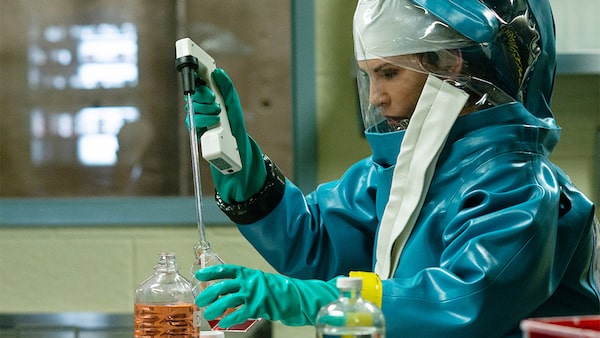
Dr. Nancy Jaax (Julianna Margulies) working in her pathology lab.Amanda Matlovich/NATIONAL GEOGRAPHIC
It starts with a very graphic scene that lasts several minutes. It’s a warning, that scene. If you don’t have the stomach to see what a virus such as Ebola does to the human body, then walk away now.
The Hot Zone (Monday, National Geographic Channel 9 p.m., continuing on consecutive nights) is a new miniseries based on Richard Preston’s 1994 non-fiction bestseller of the same name. One should emphasize the “non-fiction” aspect of it. Because while the miniseries is a thriller with plenty of danger, death and tension, it isn’t fanciful. It’s anchored in what actually happened. In cold facts.
What happened, as the TV version sees it, is that in 1989 Dr. Nancy Jaax (Julianna Margulies), a U.S. Army scientist, is sent a sample of something – she’s not sure what, at first – that is killing monkeys that are kept nearby to be used for testing in various projects. First, Jaax assumes it’s a form of simian fever. She says to a nervous colleague, “It tears the hell out of the inside of monkeys, but doesn’t pass to humans.” But she knows there is something weird about what she’s been sent. In one long, formidably tense scene in the first hour she enters a Level 4 Biosafety containment area, which contains the most deadly viruses. And in there, something very bad happens.
The drama plays out in fairly conventional manner. Jaax is super-wary. Her mostly male colleagues are more laid-back and skeptical. Topher Grace plays a young scientist who is full of himself and sees Jaax as someone who panics easily. Thus there’s a theme here about a female scientist not being taken seriously.
But the gist of the story comes into focus when Jaax calls in her old mentor Wade (Liam Cunningham from Game of Thrones) who is considered a renegade because he’s been obsessing over Ebola for years. Through Wade’s backstory, we get a sense of the brutal seriousness of the threat that is hanging over everyone.
Back at the lab, a good deal of pointless argument is going on. Another underlying theme here is the inability of government agencies to admit the truth when it surprises them. The slow unfolding of panic involves a great deal of office politics about who is a hotshot scientist and who is merely a bystander.
There have been several attempts to adapt Preston’s book as a movie. And one can see here why it never quite worked out. It’s a complex story that lacks easily defined heroes and villains. A six-part TV adaptation makes sense, though, because there is plenty of time for the characters to emerge and for the gravity of the situation to dawn on the viewer. Early on, when Jaax takes a young, cocky colleague into that Level 4 Biosafety area, she says, “Do you know how many people would die on this planet if the leftovers of this freezer ever got released?” He replies, “All of us?” She acknowledges the truth of that and adds, “And there’s not a cure on the horizon.”
With that kind of information you are meant to be very, very scared. And you are. What makes the drama a bit unwieldy, mind you, is your foreknowledge that no outbreak actually happened in the United States. Thus the meat of the drama is the built-in anxiety, not so much about the situation being dramatized, but the disease at its core.
Jaax is given a family life in this TV adaptation. Noah Emmerich from The Americans plays her husband. Who spends most of the time fretting. There are domestic scenes to add human interest to what is essentially a horror story about scientists battling each other, and bureaucrats and an actual disease. Some of this material would seem jarringly added to the main plot were it not for the cast. Margulies is very good as a stern, coolly efficient scientist who has little patience with time-wasting men and Emmerich is one of the few actors who could bring depth to what is a thankless role.
The Hot Zone is good, and scarily effective at times. It’s not for everyone and that opening sequence will test your mettle for it. But if the fact that “a hundred million viruses can be on the head of a needle” is your kind of drama, it will certainly satisfy.